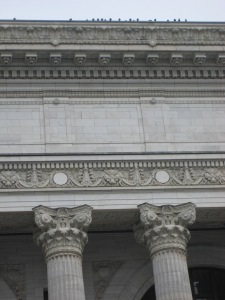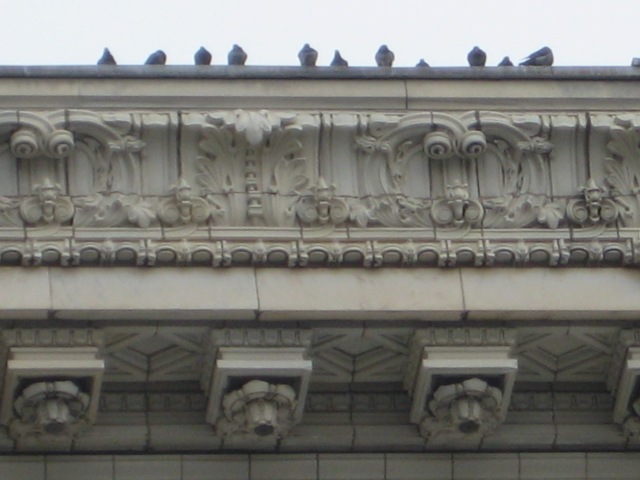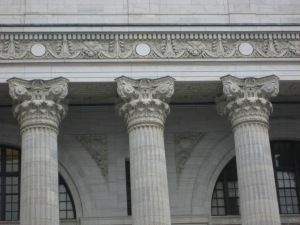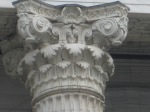Or something built by spendthrift emperors in Ancient Rome.
This is the State Education Department building in Albany, NY.
It’s really a magnificent building. Based on the greatest traditions of Western architecture, only on a huge scale. You could comfortably fit about eight Parthenons inside it. 
I marvel at the beauty of this building, and also at what’s perched on top of it.
Now, if you’ve been reading this blog you know I like odd plants. My favorites of all are dandelions and poison ivy. I just have a thing for the unloved ones. And so, being the perverse creature I am, my favorite birds are crows, gulls, and (sorry) pigeons.
Yes, pigeons. Feathered rats. The dandelions of the avian world.
I know most people look down on pigeons. But I always admire the survivors, the tough ones, the species that flourish even in the face of humans’ best attempts to eradicate them.
How do pigeons do it? I mean, it certainly isn’t by being crafty and outsmarting humans. Pigeons are not among the most intelligent of animals. Or at least they don’t look smart…they waddle around sticking out their chests and doing that head-bobbing thing.
But actually, maybe they’re not so dumb. A study in the December issue of the journal Science showed that pigeons can do as well as monkeys (and probably better than me) in learning mathematical concepts, like putting groups in numerical order based on how many objects are in the group. It’s been well proven that pigeons, like crows, can identify individual humans by facial characteristics. Pigeons have adapted very successfully to life in cities (a feat I certainly haven’t accomplished.)
Pigeons aren’t a native species, but they’ve come to fill the niche of being a major food source for native birds of prey. Peregrine falcons, in particular. The endangered peregrines could never have made their stunning come-back, nesting on skyscrapers in cities, without an abundant supply of plump and juicy pigeons.
As with dandelions, the problem with pigeons is mostly more aesthetic than ecological. They’re pests, they’re weeds, they mess up that which we prefer to be tidy (lawns, sidewalks, the tops of statues’ heads…)
Anyway, here on top of the most impressive building in the state capital, a temple dedicated to education–arguably humanity’s noblest and most lofty goal–are the pigeons.
You have to ask the question here: who’s looking down on whom?







LOLed all through your blog, as always! You’re the first person I’ve ever know to like poison ivy and I always imagined the Parthenon to be bigger! And pigeons – sounds like they can do the same kind of math my grandson is learning in kindergarten! When my kids were young and we had a small city back yard where we fed the birds, we had 2 almost-pet pigeons that we named Bert and Ernie… I had forgotten all about that… thanks for the neat info and triggering memories!
Did you know Thomas Jefferson planted poison ivy at Monticello as an ornamental? True!